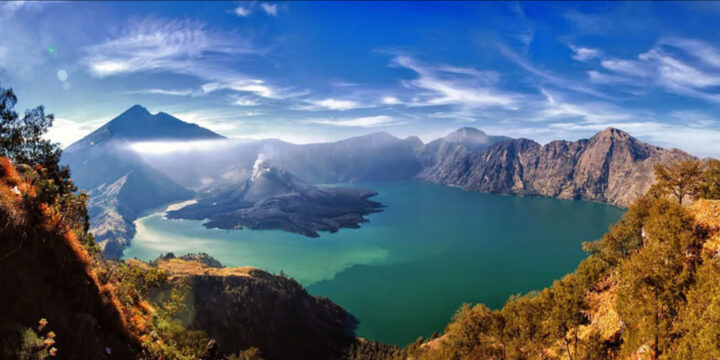Lake Anak Segara (with Mt Rinjani in the background) is all that remains of the mighty Mt Samalas.
Standing at 3726 metres, Mt Rinjani is an active volcano and the second tallest peak in Indonesia. (The highest, at 3805m, is Mt Kerinci in Sumatera.)
The native Sasak consider Rinjani to be a sacred mountain and to Indonesian Hindus, it is one of the three holy mountains, including Mt Agung in Bali and Mt Bromo in East Java.
Rinjani has erupted around 20 times since record-keeping began in 1847 but lava flows have been minimal and only recorded a handful of times. The last eruption was in 2010.
A crater lake on the way to the summit, known as “Anak Segara” (Child of the Sea – a reference to the lake’s deep blue colour) is all that remains of Rinjani’s older sister, Mt Samalas.
Samalas is estimated to have stood over 4,000 metres above sea level before erupting in 1247.
Eight times as powerful as the 1883 eruption of Mt Krakatoa, it was one of the largest volcanic eruptions of all time, pushing an estimated 40 cubic kilometres of volcanic matter into the atmosphere, and causing disruption to weather patterns for a number of years and contributing to crop failures and famine as far away as northern Europe and Africa.
(If one volcanic eruption can do that don’t tell me that humans pumping carbon into the atmosphere for 200 years can have no effect on climate change!)
Silica deposits found in sub-strata as far north as Greenland and as far south as Antarctica have long indicated the occurence of such a mighty volcanic event ocurring sometime in the mid 13th century but solid evidence linking the episode to the Samalas eruption was only estblished in 2013, with the discovery of the “Badad Lombok”, an eyewitness account of the eruption written on palm leaves in Old Javanese. Carbon-dating and silica-matching techniques have since confirmed the Samalas eruption as the source.
Two small volcanic cones have formed in the lake since the 1257 eruption and most of Rinjani’s volcanic activity over the past 200 years has occurred through these.
A trek to Rinjani’s summit is one of the most popular yet most challenging of all the activities on Lombok.
A trek to the rim of the crater lake can be completed in a day but is a 16hr round trip, typically beginning around midnight. A 2 day/1 night trip will take you to right to the lake’s edge, whereas the summit trek can take 3-4 days, depending on how fit you feel, leaving either from Senaru on the mountain’s northern flank or Sembalun on the eastern side.
It is nothing if not a difficult trek and one that requires a reasonable level of fitness and determination and one which also definitely requires a guide.
A number of reputable companies offer tours but the price can vary greatly so do your research and maybe don’t book until you get here and have a chance to ask around.
